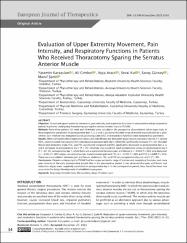Evaluation of upper extremity movement, pain intensity, and respiratory functions in patients who received thoracotomy sparing the serratus anterior muscle
Özet
Objective: To evaluate upper extremity movement, pain intensity, and respiratory functions in preoperative and postoperative periods in patients undergoing thoracotomy sparing the serratus anterior muscle (TSSAM).
Methods: Forty-three patients (25 male and 18 female) were included in this prospective observational cohort type study. In the preoperative period and on postoperative days 1, 2, 3, and 5, ipsilateral shoulder range of motion was evaluated by a goniometer, pain intensity was evaluated by a visual analog scale (VAS), and respiratory functions were evaluated by spirometry.
Results: When compared with preoperative values, shoulder flexion and abduction angle, forced expiratory volume in 1 second (FEV1), and functional vital capacity (FVC) decreased on postoperative day 1, while VAS significantly increased (P <.05). Shoulder flexion and abduction angle, FEV1, and FVC significantly increased and VAS significantly decreased on postoperative days 2, 3, and 5 compared to postoperative day 1 (P <.05). However, they could not reach preoperative values on postoperative day 5 (P <.05). On postoperative day 1, while there was a correlation between pain and flexion (r = -0.438; P =.003) and abduction (r = -0.503; P =.001) angles, no correlation was found between pain and FEV1 (r = -0.189; P =.225) and FVC (r = 0.009; P =.953). There was no correlation between pain and flexion, abduction, FEV1, and FVC on postoperative days 2,3, and 5 (P >.05).
Conclusions: Patients undergoing the TSSAM had less upper extremity range of motion and respiratory functions and more pain intensity in the early postoperative period than in the preoperative period. It was observed that pain and flexion and abduction angles were negatively correlated on postoperative day 1. In the postoperative period, they should be taken into account in the design/development of rehabilitation programs.


















